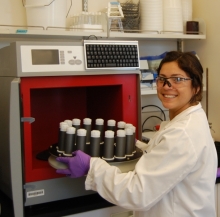
Major:
Mentor(s):
Faculty Sponsor(s):
Faculty Sponsor's Department(s):
Project Title:
Project Description:
Advances in the field of nanotechnology in the past decade have attracted the attention of industries, and consequently increased the production of a wide range of nanoparticles (NPs). Due to their novel properties and uses, the long term implications of NPs released into the environment are still largely not understood. This fuels the motive to learn more about the fate, transport, and effects of NPs in the environment, which will help create policies that mitigate potential environmental hazards. Herein, we analyzed three commercially available sunscreens containing two common metal oxide NPs, titanium dioxide (TiO2) and zinc oxide (ZnO). The sunscreens were applied to leather chamois and porcine skin to simulate the application on human skin. Then were exposed to chlorinated, deionized, and ocean water and the concentration of metal oxides released in the media was quantified. Initial studies on these materials show that the concentration of ZnO found in raw sunscreen samples is greater than that of TiO2. It is anticipated to find a larger concentration of ZnO than TiO2 in aqueous test media as well. This is a concern because of the toxicity found in dissolved ZnO. The ζ-potential of various samples pertaining to different sunscreen concentrations resulted negative values ranging from 20-40 mV, indicating moderate colloidal stability. Particle size was also investigated resulting in the range of 300-1400 nm suggesting particle sedimentation. By combining these results with other studies investigating NP toxicity, the implications of these materials on aquatic and terrestrial life can be predicted.
